TURKEY
Turkey has been called "the cradle of civilizations" and by traveling through this historic land, you will discover exactly what is meant by this phrase. Turkey boasts a rich culture that has made a lasting impression on modern civilization through the centuries. The legacy of all those admirable cultures make Turkey a paradise of information and cultural wealth. Hattie, Hittites, Carians, Lelegians, Phrygians, Urartians, Lycians, Lydians, Ionians, Persians, Macedonians, Romans, Byzantines, Seljuks, and Ottomans have all made important contributions to Anatolian history, and ancient sites and ruins scattered throughout the country give proof of each civilization's unique distinction.
No doubt, people always have been proud of breathing on this amazing peninsula, combining different cultures, customs and traditions, and she, once again started to present her hospitality and beauty to guests from all around the world.
On this page we would like to give you some basic information about Turkey, as well as places that you can visit in Turkey.
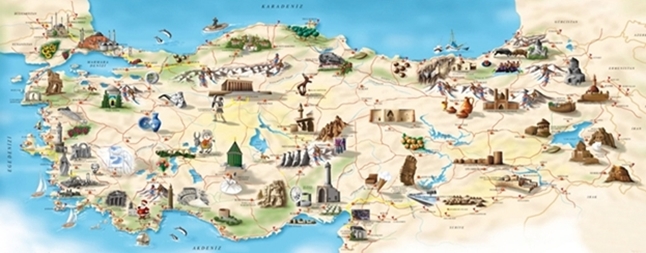
 TURKEY INFO
TURKEY INFO
Official Name : Republic of Turkey (Turkiye Cumhuriyeti).
Capital: Ankara is the capital of Turkey with 4 million population. However, Istanbul is the biggest city with 12 million population.
Population: Turkey's population is slightly over 70 million.
Climate: Due to its size, Turkey enjoys a variety of climates, changing from the temperate climate of the Black Sea Region, to the continental climate of the interior and to the Mediterranean climate of the Aegean and Mediterranean coastal regions.
Currency: Turkey uses Turk Lirası (Turkish Lira) with the symbol of TL (and TRY in international finance). In 2005, six digits from the currency is removed and 1 Million Turkish lira became 1 Turkish Lira. You can check the actual exchange rates from www.tcmb.gov.tr
Religion: Although 98% of the whole population are Moslems, the secular form of the state guarantees complete freedom of worship to non-Moslems.
PLACES TO VISIT IN TURKEY
Istanbul
Please visit our Istanbul Guide page.
Cappadocia
Please visit our Cappadocia Guide page.
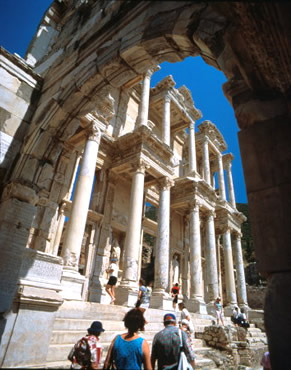 Ephesus
Ephesus
The ruins of Ephesus is one of the world's greatest archaeological sites. It is located 75 km south of Izmir. In Hellenistic times, Ephesus became the most densely populated city in Anatolia with a population of more than 200 000. The city reached the peak of its glory under the Roman rule and became a very important center of trade and commerce. A majority of the monuments that exist now date to that period. It was also the leading political and intellectual center, with the second school of philosophy in the Aegean. The Temple of Artemis at Ephesus was one of the seven wonders of the ancient world.
Ephesus also emerged as one of the main centers of early Christianity. St. Paul remained in the city for three years during his third missionary journey (53-57). The Apostle John also came to Ephesus to live and was finally buried here. Ephesus was one of the Seven Churches mentioned in his book of Revelation. Tradition has it that St.John brought Virgin Mary to Ephesus after Christ's crucifixion and that she lived and died in a small wooden house located about three miles away in the forested mountain above Ephesus at the age of 101. In the year 431 the Third Ecumenical Council was held in the Basilica of the Virgin Mary in Ephesus. In the following century, Emperor Justinian(527-565) built a massive church at the spot where St John was believed to have been buried. It became an important site of pilgrimage throughout the Middle Ages.
The city ruins include the agora, theater, gymnasium, stadium, Church of the Virgin Mary, Temple of Serapis, Temple of Hadrian, Fountain of Trajan, Scholasticia Baths, Temple of Domitian and terrace houses that once belonged to rich Ephesians, as well as the Celsus Library. The Cathedral of St. John is on the Ayasuluk hill above the city.
Pamukkale
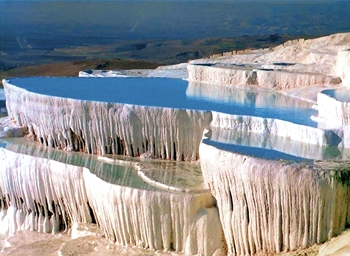 This sight of spectacular beauty is located in the inner Aegean region. The terraces over 300 feet in height composed of layers of the accumulated limestone sediment have been gradually formed in the course of the ages. For thousands of years a deep underground spring on the hills above has been pouring out streams of hot, mineral-saturated water. As the water has flowed down the mountainside, the water's rich mineral content has coated them in a smooth layer of white calcareous rock. Since these white slopes resemble castles when observed from the plain, the area is called Pamukkale which means cotton castle in Turkish. Several Roman emperors came to bathe in these thermal pools. The area is still one of the leading hot springs in Turkey.
This sight of spectacular beauty is located in the inner Aegean region. The terraces over 300 feet in height composed of layers of the accumulated limestone sediment have been gradually formed in the course of the ages. For thousands of years a deep underground spring on the hills above has been pouring out streams of hot, mineral-saturated water. As the water has flowed down the mountainside, the water's rich mineral content has coated them in a smooth layer of white calcareous rock. Since these white slopes resemble castles when observed from the plain, the area is called Pamukkale which means cotton castle in Turkish. Several Roman emperors came to bathe in these thermal pools. The area is still one of the leading hot springs in Turkey.
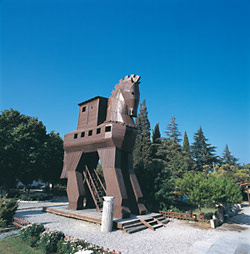 Troy
Troy
Ancient city of Troy is located 30 km south west of Canakkale province in the Marmara Region of Turkey. This is one of the most important historical cities of Anatolia. Archeological excavations have revealed nine separate periods of settlement at this site, including ruins of city walls, house foundations, a temple and a theater.
The earliest settlement dates from five thousand years ago and the last coincided with the late Roman period. Famous Trojan wars, depicted in Homer's epic Iliad took place here at about 1200 BC. A symbolic wooden horse at this site commemorates this legendary war.
Nemrut
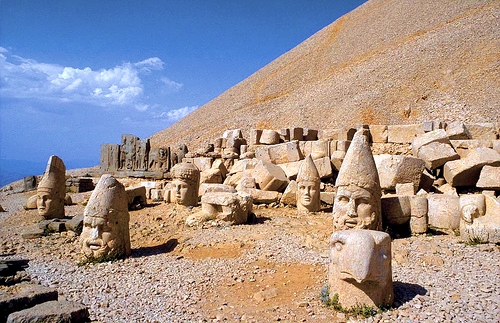 Antiochos I, ruler of the Commagene Kingdom in the first century BC, built himself this funeral monument on top of Mount Nemrut in eastern Turkey. It consists of a tumulus and a dozen gigantic statues representing Antiochus I, eagles, lions and ancient gods. Lion and eagle statues were used as the guardians. The tumulus is 50 m high and 150 m. in diameter. Although the inscriptions at the back of the thrones on east and west terraces record that Antiochos I had chosen the hierothesion as his sacred last resting place or a place where his body will sleep for endless eternity, sysmic research did not show any grave chamber or large cavity in the tumulus. The average height of the statues is 26-33 feet. These are made of stone, too heavy and large to be carried to the museum and remain where they were originally erected. Time has inflicted heavy damage on the sculptures- their bodies sit with their beautifully carved heads at their feet.
Antiochos I, ruler of the Commagene Kingdom in the first century BC, built himself this funeral monument on top of Mount Nemrut in eastern Turkey. It consists of a tumulus and a dozen gigantic statues representing Antiochus I, eagles, lions and ancient gods. Lion and eagle statues were used as the guardians. The tumulus is 50 m high and 150 m. in diameter. Although the inscriptions at the back of the thrones on east and west terraces record that Antiochos I had chosen the hierothesion as his sacred last resting place or a place where his body will sleep for endless eternity, sysmic research did not show any grave chamber or large cavity in the tumulus. The average height of the statues is 26-33 feet. These are made of stone, too heavy and large to be carried to the museum and remain where they were originally erected. Time has inflicted heavy damage on the sculptures- their bodies sit with their beautifully carved heads at their feet.
Konya
Founder of the Mevlevi Order, Muhammed Celaleddin-i Rumi, known in the West as the Whirling Dervishes, lived in Konya from 1228 until his death in 1273. He was given the name Mevlana (Our High Master) by his followers.
The nearly 6500 m2 land, on which the convent lies, used to be a rose garden belonging to Seljuk Sultan Alaaddin Keykubat. He gave the area to Mevlana's father, Bahaddin Veled. as a gift. Bahaddin Veled was buried here in accordance with his will. From that day on, this place became a popular visiting spot. The building of the tomb began in 1274, only after the burial of Mevlana beside his father. In 1396, the tomb was covered by a cone shaped dome decorated by exquisite turquoise tiles.
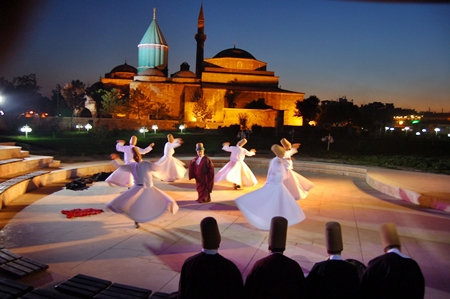 The building has gone through many modifications during different periods in history and it has turned into a collection of buildings, an institution. In 1926, the Mevlana Convent opened as a museum. The artifacts presented to the convent throughout the centuries are on display. The most interesting section of the museum is under the green dome where the sarcophagi of Mevlana and his son, Sultan Veled, stand. On display are hand-written copies of the sayings and books about Mevlana and Mevlevi order, musical instruments, metal glass and wooden objects, carpets and kilims. In the former dervish cells, the garments of the order are exhibited.
The building has gone through many modifications during different periods in history and it has turned into a collection of buildings, an institution. In 1926, the Mevlana Convent opened as a museum. The artifacts presented to the convent throughout the centuries are on display. The most interesting section of the museum is under the green dome where the sarcophagi of Mevlana and his son, Sultan Veled, stand. On display are hand-written copies of the sayings and books about Mevlana and Mevlevi order, musical instruments, metal glass and wooden objects, carpets and kilims. In the former dervish cells, the garments of the order are exhibited.
Safranbolu
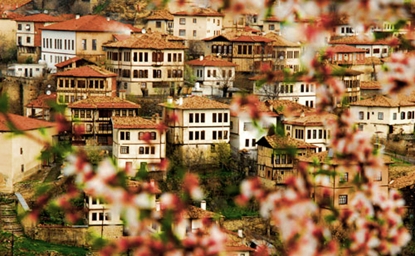 The known history of Safranbolu, located near the north western Black Sea coast of Anatolia, in Karabuk nearby Zonguldak, dates back as far as 3000 BC.
The known history of Safranbolu, located near the north western Black Sea coast of Anatolia, in Karabuk nearby Zonguldak, dates back as far as 3000 BC.
Once a city of Roman Province of "Paphlagonia", Safranbolu has hosted many civilizations including the Roman, Byzantine, Seljuk and Ottoman Empires throughout its history. During the Ottoman era the town served as an important junction on the Kastamonu - Gerede (Bolu)- Istanbul route of the famous silk road. Safranbolu was at the same time a popular residence for Ottoman Royalty close to the Sultan and Grand Viziers.
Safranbolu displays its extremely rich historical and cultural heritage through 1008 architectural structures displaying a good example of Turkish architecture, all preserved in their original environment.
Safranbolu is listed in the world Cultural Heritage list by UNESCO in appreciation of the successful efforts in the preservation of its heritage as a whole. Safranbolu has deserved its real name for its houses.
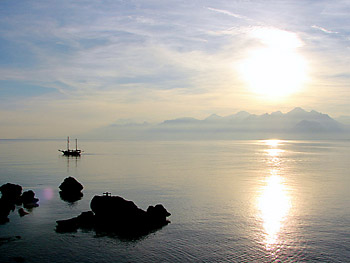 Antalya
Antalya
Antalya, Turkey's principal holiday resort in the Mediterranean region (ancient Pamphylia), is an attractive city with shady palm-lined boulevards, a prize-winning marina on the Mediterranean. In the picturesque old quarter, Kaleici, narrow winding streets and old wooden houses abut the ancient city walls.
The region around Antalya offers sights of astonishing natural beauty as well as awesome historical remains. You can walk behind the cascade, a thrilling experience, at the Upper Düden Waterfalls, 14 km northeast of Antalya. On the way to Lara Beach, the Lower Düden Waterfalls plunge straight into the sea. The nearby rest area offers an excellent view of the falls; the view is even more spectacular from the sea. Kursunlu Waterfalls and Nilüfer Lake, both 18 km from Antalya are two more places of superb natural beauty.
The sandy Lara Beach lies about 12 km to the east. Closer to Antalya, but to the west, the long, pebbled Konyaalti Beach offers a view of the breathtaking mountain range. A little further the Bey Dagi (Olympos) National Park and Topcam Beach provide more splendid vistas. There are camping grounds at the north end of the park should you decide to linger amid the natural beauty. For a panoramic view of the area, drive to the holiday complex on top of the Tünektepe Hill.
Trabzon
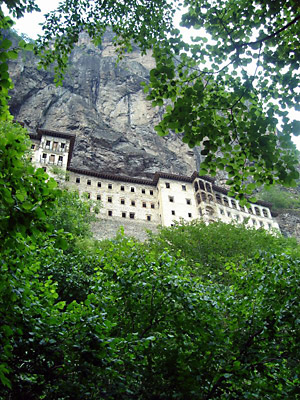 Trabzon is an old located on northern Turkey in the Eastern Black Sea Region and famous with Sumela Monastery and St. Sophia Church.
Trabzon is an old located on northern Turkey in the Eastern Black Sea Region and famous with Sumela Monastery and St. Sophia Church.
Situated in a very beautiful and natural setting, Sumela Monastery built in the 14th century is nestled into the side of rocks in a green valley. The setting is 1200 meters above the sea level. Two Greek monks, Barnaby and Sophronios started the original building. The 7th century Icon apparently painted by an anonymous Trabizond (Trabzon) artist became the symbol of the monastery. The Church of the Assumption of the Virgin and the large monastery complex had 5 floors and a total of 72 rooms. The upper floor was used as a gallery and a lookout post. The whole building was full of frescoes and the wall paintings. The large part of the building was hewn out of the rock. It stands in front of a beautiful valley scenery and sharp rocky mountains behind.
St. Sophia Church was built in covered Greek cross architecture during the reign of King Manuel I Kommenos in 13th century. Muslim Seljuk stone workers also worked for the construction of the church and it continued its service until 1670 after Ottomans invaded the region. It was converted into a mosque in 1670 and served as a storage and hospital during World War I. Later it served as a mosque again. St. Sophia Church was converted into a museum in 1964 and is located in 3 kilometers west of the city. It is not to be confused with St. Sophia Museum in Istanbul.
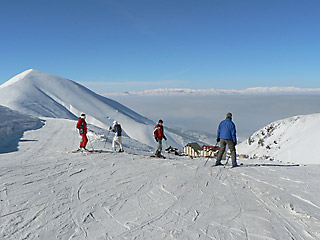 Erzurum
Erzurum
Erzurum is the largest province in Eastern Anatolia and is located on a high plateau (1950 m). Mt. Palandoken which has the longest ski runs of Turkey and host 2011 Universiade winter games is located in Erzurum and makes the city a winter sports center.
The history of the city extends back to 4000 BC and it has seen many civilizations in Anatolia. One of the most important remains from this periods is the well preserved Byzantine city walls. Most of the historical finds are kept in the collections of the Archaeological Museum, which is a part of the Erzurum Museum.
The Seljuk buildings in the town are remarkable. The Ulu (Grand) Mosque built in 1179 is interesting, with its many columns and seven wide naves. Next door to Ulu Mosque is the Cifte Minareli (Double Minaret) Medrese (theological school), which is the most famous feature of the city. It is a perfect example of Seljuk architecture, the carved portal being particularly fine. Walking south you will see the Three Tombs (Uc Kumbetler). Another interesting tomb is the elegant 13th century Hatuniye Tomb. The Yakutiye Medrese of the 13th century is one of the most important historical monuments of Erzurum with its beautiful portal and richly tiled minaret. Here is an elaborate mosque built by the great architect Sinan in the 16th century, the Lala Mustafa Pasa Mosque.
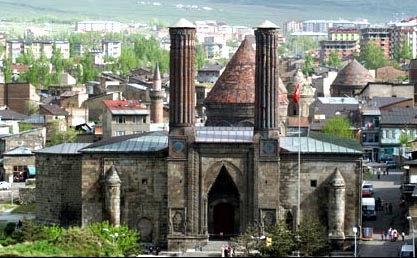 Erzurum has a specific local black stone (Oltu tasi, Jet) which is carved to produce jewelry, rosary beads, key-chains, pipes and boxes, which you may see while wandering around, especially in Tashan. Oltu stone, which has been carved in Erzurum since the 18th century, is one of the best examples of semi-precious stones to be found in the world. The Aziziye monument commemorating the Turkish - Russian War, the citadel and Bell Tower, the Rüstem Pasa Caravanserai and the Bedesten are other historical places of interest.
Erzurum has a specific local black stone (Oltu tasi, Jet) which is carved to produce jewelry, rosary beads, key-chains, pipes and boxes, which you may see while wandering around, especially in Tashan. Oltu stone, which has been carved in Erzurum since the 18th century, is one of the best examples of semi-precious stones to be found in the world. The Aziziye monument commemorating the Turkish - Russian War, the citadel and Bell Tower, the Rüstem Pasa Caravanserai and the Bedesten are other historical places of interest.
